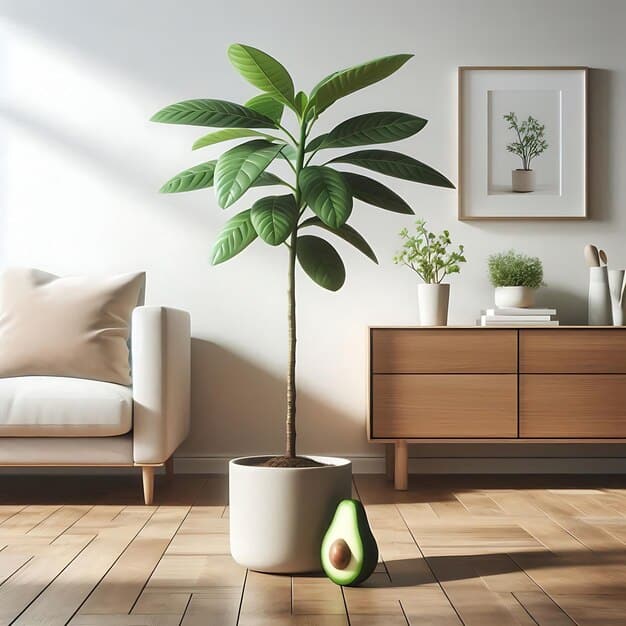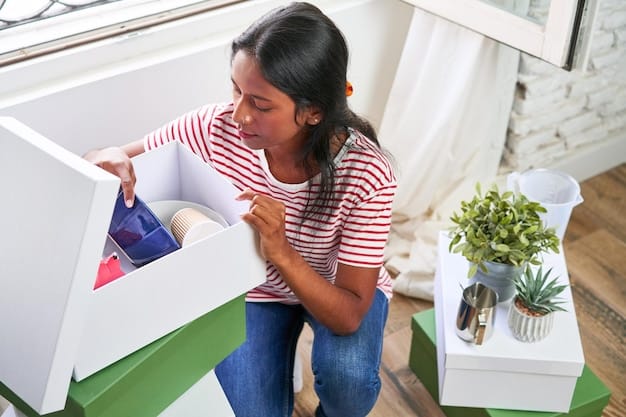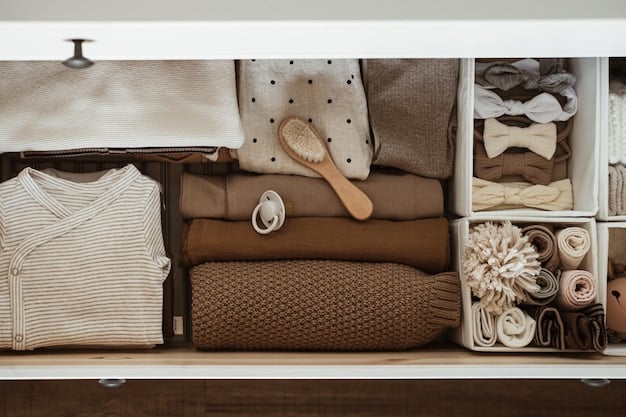Embrace Minimalism: 10 Tips for a Clutter-Free Life

Anúncios
Embrace Minimalism is a lifestyle choice focused on intentional living and minimizing clutter; this article explores 10 practical tips, guiding you towards a more simplified, intentional, and fulfilling life by reducing excess and focusing on what truly matters within the **Lifestyle** category.
Ready to declutter your life and embrace a more intentional way of living? **Embrace Minimalism: 10 Tips for a Clutter-Free and Intentional Life** is more than just tidying up; it’s about creating space for what truly matters.
Anúncios
Understanding the Essence of Minimalism
Minimalism isn’t about deprivation; it’s about intentionality. It’s a conscious decision to rid your life of excess possessions, distractions, and commitments that don’t add value. This allows you to focus on experiences, relationships, and personal growth.
It’s about creating a life that reflects your values and priorities, leading to greater contentment and freedom.
Anúncios
The Core Principles of Minimalism
At its core, minimalism operates on a few key principles that guide its adherents towards a more intentional and fulfilling existence.
- Intentionality: Every possession and activity should serve a purpose or bring joy.
- Decluttering: Regularly removing items that no longer add value to your life.
- Conscious Consumption: Being mindful of purchases and avoiding impulse buys.
- Focus on Experiences: Prioritizing experiences and relationships over material possessions.
By understanding these principles, you can start to incorporate minimalism into your daily life more effectively.

Tip 1: Start with a Decluttering Challenge
A decluttering challenge can be a fun and effective way to kickstart your minimalist journey. The goal is to remove a certain number of items from your home over a set period.
This provides a structured approach to decluttering and helps you see results quickly, motivating you to continue.
The 30-Day Minimalism Game
One popular challenge is the 30-day minimalism game. On the first day, you get rid of one item. On the second day, two items. And so on, until you’re getting rid of 30 items on the final day.
This can seem daunting, but it’s an excellent way to quickly reduce clutter and change your mindset about possessions.
Tip 2: Identify Your Values
Understanding your core values is crucial for intentional living. When you know what truly matters to you, it becomes easier to make decisions about what to keep in your life and what to let go of.
Ask yourself what brings you joy, fulfillment, and a sense of purpose. These are your values.
Aligning Possessions with Values
Once you’ve identified your values, assess your possessions and activities. Do they support your values, or do they distract you? If something doesn’t align with your values, consider removing it from your life.
- Family time vs. excessive work hours
- Health vs. unhealthy habits
- Creativity vs. mindless consumption
Aligning your life with your values is a continuous process that leads to a more meaningful existence.
Tip 3: Embrace Digital Minimalism
In today’s digital age, clutter extends beyond physical possessions. Digital devices and online platforms can be major sources of distraction and overwhelm.
Digital minimalism involves intentionally decluttering your digital life, from social media accounts to email subscriptions.
Strategies for Digital Decluttering
Start by unsubscribing from unnecessary emails and unfollowing accounts that don’t add value to your life. Set time limits for social media use and create tech-free zones in your home.
- Turn off notifications
- Organize your digital files
- Limit screen time before bed
Creating a healthier relationship with technology can free up time and mental space for more meaningful activities.
Tip 4: One In, One Out Rule
To prevent future clutter, implement the “one in, one out” rule. For every new item you bring into your home, get rid of something similar.
This helps maintain balance and ensures that you’re not accumulating unnecessary possessions.
Exceptions to the Rule
Of course, there are exceptions to this rule. Essential items that you genuinely need don’t always require something to be removed. However, use this rule as a general guideline to stay mindful of your consumption habits.
Tip 5: Mindful Consumption
Mindful consumption is about being aware of your purchasing habits and making intentional choices. Before buying something new, ask yourself if you truly need it, if it aligns with your values, and if it will add value to your life.
Avoid impulse buys and resist the pressure of consumer culture.
Questions to Ask Before Buying
Consider these questions before making a purchase:
- Do I really need this item?
- Will it add value to my life?
- Is there a more sustainable or ethical option?
By practicing mindful consumption, you can reduce unnecessary spending and create a more sustainable lifestyle.
Tip 6: Create a Capsule Wardrobe
A capsule wardrobe is a collection of essential clothing items that can be mixed and matched to create a variety of outfits. This simplifies your wardrobe and reduces decision fatigue each morning.

Focus on high-quality, timeless pieces that you love and that fit well.
Benefits of a Capsule Wardrobe
A capsule wardrobe saves time, money, and closet space. It encourages creativity with your existing wardrobe and helps you develop a personal style that reflects your values.
Tip 7: Find Joy in Experiences
Minimalism isn’t about getting rid of everything, it’s about focusing on what truly matters. Prioritize experiences and relationships over material possessions.
These experiences often bring more lasting joy and fulfillment than owning more things.
Examples of Meaningful Experiences
Consider investing in:
- Travel
- Concerts and shows
- Classes and workshops
- Quality time with loved ones
These experiences create memories and strengthen relationships, enriching your life in ways that possessions can’t.
Tip 8: Practice Gratitude
Gratitude is a powerful tool for contentment. Taking time each day to appreciate what you have can shift your focus from what you lack to what you already possess.
This reduces the desire for more possessions and fosters a sense of satisfaction.
Ways to Cultivate Gratitude
Try these practices:
- Keep a gratitude journal
- Express appreciation to others
- Reflect on positive moments
Cultivating gratitude can transform your mindset and improve your overall well-being.
Tip 9: Develop a Decluttering Routine
Decluttering should be an ongoing process, not a one-time event. Develop a regular routine for decluttering your home and digital life.
This prevents clutter from accumulating and makes the process more manageable.
Strategies for Regular Decluttering
Create a schedule that works for you, whether it’s decluttering one area per week or doing a quick sweep every month. Set reminders and make it a habit.
Tip 10: Be Patient and Kind to Yourself
**Embrace Minimalism** is a journey, not a destination. It takes time to change your habits and mindset. Be patient with yourself and celebrate small victories.
Don’t get discouraged by setbacks; learn from them and keep moving forward.
The Importance of Self-Compassion
Remember, the goal is to create a life that brings you joy and fulfillment. If you’re feeling overwhelmed or stressed, take a step back and reassess your approach. Be kind to yourself and enjoy the process.
Minimalism should enhance your life, not restrict it.
| Key Point | Brief Description |
|---|---|
| 🗑️ Declutter Regularly | Remove items that no longer add value. |
| 🌱 Mindful Consumption | Be aware of purchasing habits. |
| 📱 Digital Detox | Reduce screen time and digital clutter. |
| ❤️ Value Experiences | Prioritize experiences over possessions. |
FAQ
▼
Minimalism is a lifestyle focused on intentionally living with only the things you truly need or that bring you joy. It’s about reducing excess to create space for what matters most.
▼
Begin with one area at a time, like a drawer or closet. Sort through items, asking if they serve a purpose or bring joy. Donate, sell, or discard what you no longer need.
▼
No, minimalism is generally less expensive. It encourages mindful consumption, reducing impulse purchases and focusing on quality over quantity, which can save money over time.
▼
Yes, digital minimalism involves reducing screen time, unsubscribing from unnecessary emails, and unfollowing accounts that don’t add value, creating a healthier relationship with technology.
▼
Develop a regular decluttering routine, practice mindful consumption, and continuously align your possessions and activities with your core values to maintain your minimalist approach.
Conclusion
By **Embrace Minimalism**, you can transform your life into one filled with purpose, intention, and joy. Start with these ten tips, and adapt them to fit your own unique journey. The path to a clutter-free and intentional life is within your reach.





